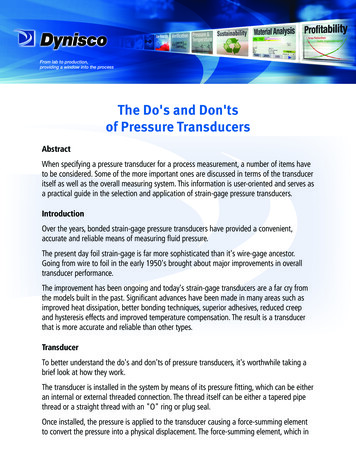
Transcription
From lab to production,providing a window into the processThe Do's and Don'tsof Pressure TransducersAbstractWhen specifying a pressure transducer for a process measurement, a number of items haveto be considered. Some of the more important ones are discussed in terms of the transduceritself as well as the overall measuring system. This information is user-oriented and serves asa practical guide in the selection and application of strain-gage pressure transducers.IntroductionOver the years, bonded strain-gage pressure transducers have provided a convenient,accurate and reliable means of measuring fluid pressure.The present day foil strain-gage is far more sophisticated than it's wire-gage ancestor.Going from wire to foil in the early 1950's brought about major improvements in overalltransducer performance.The improvement has been ongoing and today's strain-gage transducers are a far cry fromthe models built in the past. Significant advances have been made in many areas such asimproved heat dissipation, better bonding techniques, superior adhesives, reduced creepand hysteresis effects and improved temperature compensation. The result is a transducerthat is more accurate and reliable than other types.TransducerTo better understand the do's and don'ts of pressure transducers, it's worthwhile taking abrief look at how they work.The transducer is installed in the system by means of its pressure fitting, which can be eitheran internal or external threaded connection. The thread itself can be either a tapered pipethread or a straight thread with an "O" ring or plug seal.Once installed, the pressure is applied to the transducer causing a force-summing elementto convert the pressure into a physical displacement. The force-summing element, which in
The Do's and Don'ts of Pressure Transducersmost cases is a diaphragm, develops surface strains proportional to the pressure.Strain-gage pressure transducers, by design, are rugged, accurate and stable. They arecapable of operating in severe shock and vibration environments as well as a wide variety ofelectrical and pressure connections can be installed directly at the point of measurement.Foil Strain-GageIn order to utilize the pressure to strain relationship, foil strain-gages are bonded to thediaphragm and become the primary sensors. As such, they change resistance as a functionof the diaphragm strain, which is, in turn, related to pressure.The strain-gages, usually four (4) in number, are wired in series to form a WheatstoneBridge. The bridge concept is used since it's the simplest and most accurate methodconceived for measuring small resistance changes. With voltage applied to two (2) oppositecorners of the bridge, an electrical output signal is developed proportional to the appliedpressure. The output signal level is in millivolts per applied volt and is collected at theremaining two (2) corners of the bridge.Transducer SignalBecause they can convert fluid pressure into an electrical signal, transducers are userfriendly. The signal can be transmitted from the pressure sit to remote locations and used forspecific control, monitoring and measurement purposes. They interface with data loggers,data acquisition systems, computers and readout instruments.Strain-gage transducers are available in both low and high level outputs. The low leveloutput for foil-gage transducers is a 3 mV/V or 30 millivolts at 10 VDC input. High leveloutputs are 5 VDC and 10 VDC at an input voltage of 24 to 32 VDC and 4-20mA at a 12 to36 VDC input. For the digital world, the analog-to-digital (A/D) converter is used to translatethe analog signal into digital bits.Although we are talking about a rugged device, requiring virtually no maintenance,transducers are subject to misapplication and damage.Proper application with knowledge of certain limitations, will assure long transducer life andhigh integrity performance.
The Do's and Don'ts of Pressure TransducersConsiderationsThe factors that have to be considered in the care and feeding of transducers can be placedinto the following categories:1. Pressure RangeTransducers are designed to provide a specific electrical output for a given pressurerange. This relationship is always given in the manufacturer's product specifications. Ingeneral, transducers are available in a number of discreet pressure ranges from 0-5 psito 0-100,000 psi rated pressure. Many suppliers can provide some or all of the ranges inhigh level or low level electrical outputs.In choosing a transducer, select a pressure range such that operating pressure isapproximately 80% of full-scale. Also, select an electrical output level that is compatiblewith your system needs. If transducer cable runs exceed 100 feet, consider a high levelunit if the environment is intolerant of low-level signals.2. Pressure/Electrical ConnectionsAll transducers require two connections, a mechanical pressure connection and anelectrical connections. Since there are no industry standards established, you have tocheck the transducer manufacturer's data to determine the configuration he offers withhis products.Pressure fittings are normally made of stainless steel and designed to be leak-free withinthe operating parameters of the transducer.The electrical termination on the transducer is usually a multi-pin connector or a cable.The connector usually has 6 pins for compatibility with 6 conductor cables assembliesthat go from the transducer to the instrumentation.Make certain that the transducer you select meets not only performance specifications,but properly mate with your electrical and mechanical connections. There is nothingmore frustrating than purchasing a transducer and finding out that it doesn't fit in yourstandard pressure port.The same is true of your electrical connection, which has added dimension. Not onlymust the connection be compatible with your system mechanically, it must also have thesame wiring code for electrical pin-to-pin compatibility.Pay attention to both the pressure and electrical interface.
The Do's and Don'ts of Pressure Transducers3. Handling and InstallationA pressure transducer is a rugged device, built in to withstand rigors of the industrialworld. It performs its task extremely well and requires very little attention once installedand operating. However, it is a precision measuring device and does require a certainamount of care to maintain its integrity.During installation, take care not to damage the electrical connector. This is probablythe most vulnerable part of the transducer. Denting the connector shell or bending a pincould put the unit out of commission.Many high level transducers have zero and span adjustment access holes located onthe transducer's connector plate. Make certain that these units are installed so theadjustments can be reached with a screwdriver.The pressure fitting on the transducer is designed to properly secure the unit in place. Dotighten the transducer well to avoid the possibility of leaks. Proper tightening will notharm the transducer's performance and will assure leak-proof operation.4. Media CompatibilityBecause transducers are called upon to operate in a variety of pressure media, they musthave some built-in protection against hostile fluids. This is accomplished by making thepressure-sensing end out of hardened stainless steel. 'In most cases, the material is 17-4PH or 15-5 PH. To further enhance protection, the outer shell or cover is usually madefrom 303 or 304 stainless steel.Corrosion of the transducer's diaphragm can change the output sensitivity and affect itsstructural strength. In almost all system applications, the media is never a problem andshould not be of concern. However, if there is any doubt as to which material is best fora given situation, do consult the manufacturer.5. SystemTo insure accuracy and reliability, attention has to be paid to the entire system.The transducer is one component in a system that typically includes cabling, signalconditioning, amplification and readout devices.The largest sources of system error is the input wiring to the transducer. This error is dueto noise generated by electrostatic coupling and inductive pickup (EMI/RFI)The former generates noise due to coupling of the electric fields surrounding signalwires. This is brought about by the capacitance between individual conductors andbetween the conductors and ground. Capacitive coupling is more of a problem in longercables because capacitance between conductors increased with cable length.
The Do's and Don'ts of Pressure TransducersTo eliminate these unwanted signals, use shielded cable and ground only on one end ofthe shield. Do not ground both ends, or it will become a signal conductor, capacitivelycoupled to the measured signal.Motors, power lines, transformers and similar sources generate electro-magnetic fields,which can be picked up inductively. These strong magnetic fields are a source of noise,which can induce signal errors.Using twisted pairs will effectively cancel the noise due to inductive pickup. In thosecases where a low signal level cable is close to high voltage cables, the low level cablecan be run in a metal conduit.The problems caused by grounds are probably the least understood and may well be themost troublesome of all sources of noise. To help minimize grounding problems, a signalcircuit should be grounded in one (1) place only. The difference in potential betweenmultiple ground points can cause circulating currents and as a consequence generatenoise. A high level of system isolation will keep ground effects to a minimum if all elsefails.As a final note, all electrical interconnects between system components should beproperly mated, cleaned and have the highest integrity. More problems are solved in thefield by merely tightening a loose transducer connector.This should serves a s practical guide on selecting and using pressure transducers. Since itcan't cover all of your questions, consult directly with the transducer supplier for his adviceand help.www.dynisco.com 2016. Dynisco reserves the right to make changes without notice.Refer to www.dynisco.com for access to Operator Manual and other support documentation.Dynisco38 Forge ParkwayFranklin, MA 02038USAHotline1-800-Dyniscowww.dynisco.comPhone 1 508 541 9400Fax 1 508 541 6206Email infoinst@dynisco.comDynisco Europe, GmbHPfaffemstr. 2174078 HellbronnGermanyPhoneFaxEmail 49 7131 297 0 49 7131 297 166dyniscoeurope@dynisco.comDynisco ShanghaiBuilding 7A, No. 568Longpan Rd MaluJiading, 201801 ChinaPhone 86 21 34074072-819Toll Free 86 400 728 9117Fax 86 21 34074025
outputs are 5 VDC and 10 VDC at an input voltage of 24 to 32 VDC and 4-20mA at a 12 to 36 VDC input. For the digital world, the analog-to-digital (A/D) converter is used to translate . The pressure fitting on the transducer is designed to properly secure the unit in place. Do . USA Fax 1 508 541 6206 Germany Email dyniscoeurope@dynisco.com .











